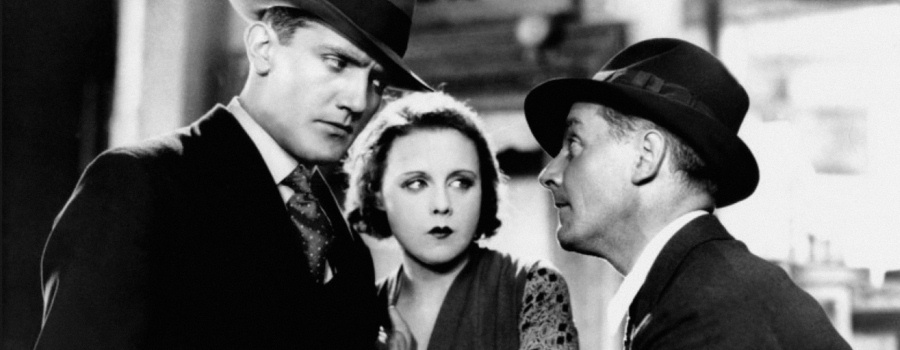A Year with Hitchcock: Blackmail, by Reed Lackey
18 Feb
Hitchcock’s first “talkie” (and largely regarded as the first British “talkie” at all) is also his first straight-forward suspense film since The Lodger seven films earlier. It required a bit of intuitive insight on Hitchcock’s part into the contemporary cinematic trends to fully create it and it remains one of the strongest entries in Hitchcock’s first decade of films.
The story begins feeling like the last few domestic dramas Hitch had made, with two lovers on a date whose tensions begin to mount as their evening plans dissolve. But the woman is hiding a little secret, and eventually leaves the restaurant with another man. What transpires following that decision drives the remainder of the narrative, as the woman is eventually driven to commit murder in self-defense. She covers her deed as best she can, but unfortunately she was seen. When her lover, a Scotland Yard detective, discovers the truth during his investigation, he is quickly confronted by the witness to his lover’s crime, and the tension alluded to in the film’s title commences.
So many of the eventual signature elements of Hitch’s work are present here. There are moments which will immediately bring to mind future films like Psycho and Saboteur, even Vertigo. It feels very much like a maestro warming up the band for the eventual symphonies to come, and I have to confess that the film provokes a great deal more anticipation than it does actual satisfaction, but that’s not to say it’s not still very good. The suspense is nearly constant, but frequently culminates in an anticlimactic or ultimately innocuous moment.
The film is definitely a “talkie”, but the remnants of the silent world are not completely gone. Hitchcock had to essentially make two films simultaneously. The producers initially wanted a full “talkie”, which had become a rapidly popular American cinematic technique. However, Hitchcock sensed their trepidation, and indeed they later asked him to revert the film to be silent after all with exception to the film’s final reel. Certain films had already been promoted as “part-sound” films, which incorporated sound into one or two key scenes but were largely silent for the remaining runtime. Hitchcock made the film as the producers requested (with “part-sound” techniques), but he intentionally crafted certain scenes to build himself a defense to reshoot them with full sound. His gambit was successful, and the result was Hitchcock’s first fully sounded picture.
The film’s most compelling moments are in its middle third, when the murder’s development and aftermath are rivetingly played out as only Hitchcock could make them. The resolution to the “blackmail” of the title is complicated thematically, toying with the grays of guilt and innocence; truth and consequence. But the film does end with a haunting and effective final shot which leads the audience to conclude that what will happen after the credits are over may not quite be a happy, hopeful ending. There is also a now famous singular shot featuring a “farewell” of sorts from Hitchcock to his silent film era wherein a villainous man stands in the shadow of a chandelier – and for a moment it appears as if he has a classic handlebar moustache.
If you’re tracking Hitchcock’s development as a teller of suspense stories, this is your second stop after The Lodger, and it’s a pretty decent step forward, even if it doesn’t quite reach the heights of Hitch’s later work. It’s nonetheless an important and quality entry in the catalogue of his stories as a filmmaker and a master of suspense.
Summary:
Accessibility – Available on several low-budget DVD collections
Themes – Crime and Punishment, Guilt
Category – Recommended




No comments yet